Pond Flood-up
Crawfish are confined to the burrow until the hard plug that seals the burrow is sufficiently softened by external moisture. Pond flooding, especially when associated with heavy rainfall, facilitates and encourages the emergence of crawfish from burrows. Brood females emerge with young (and sometimes eggs) attached to the abdomen, and hatchlings are quickly separated from the females to become independent. Because reproduction is somewhat synchronized in pond-reared crawfish, ponds are routinely flooded in autumn to coincide with the main period of recruitment. Continuous recruitment and differential growth often results in a population of mixed sizes, especially in monocropping situations (Figure 1). Typically, spawning in burrows, hatching (either in burrows or ponds) and emergence of females from burrows all take place more or less continuously from September through November. As a result, sufficient young-of-the-year crawfish are usually available throughout this time period to produce the season’s crop.
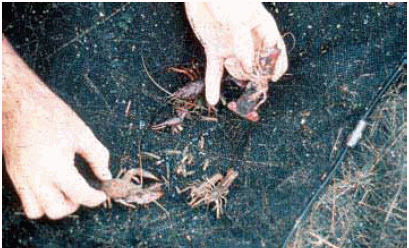
Timing of fall flooding is particularly critical in crawfish farming. The goal is to time flooding to provide the best habitat for young-of-the-year recruitment, and the most fundamental factor relating to the timing of flooding involves water temperature. Warmer water is more conducive to faster growth of crawfish. The warmer water is, however, the less oxygen it can hold. At the same time, the warmer the water is in a newly flooded field, the more rapidly oxygen will be consumed in the breakdown of vegetation. Unless extremely high amounts of water are available for daily exchanges, early flooding almost always results in depressed oxygen levels. This situation is aggravated if most of the vegetation is already dead or begins breaking down rapidly upon flooding. This occurrence can significantly reduce survival and growth of any early emerging crawfish and reduces profitability through increased pumping costs and reduced yields (because of poor utilization of forage and reduced crawfish recruitment). Therefore, timing of pond flood-up should reconcile water quality issues with optimal crawfish growth opportunities associated with warm weather.
Flooding also must be timed to coincide with the development of the forage crop, whether it be rice, sorghum-sudangrass or volunteer vegetation. If terrestrial vegetation is flooded too early, growth may be curtailed, and the breakdown process may be accelerated. In cooler waters, even poor quality forage will persist longer, and the slower breakdown process generally results in more nutrition for the crawfish crop. It is important to remember that ponds need not be fully flooded during the 1- to 2-month period when brood crawfish and their young emerge from their burrows. In some situations, young-of-the-year crawfish can successfully begin growing in as little as 4 to 6 inches of water, especially if abundant green vegetation provides cover. During the period following initial flooding, maintaining good water quality and high oxygen levels is more important than filling the pond to its full depth.
Population Management
Despite some efforts to limit farmed crawfish populations only to the red swamp crawfish, excluding the white river crawfish from ponds whenever possible, both species are responsive to routine culture practices and often coexist in production ponds. In general, these two species have environmental requirements that are conducive to the low input aquaculture systems used in Louisiana and surrounding states, and they are frequently found in the same water body. Though the abundance of one species may vary among and within culture ponds from year to year, red swamp crawfish most often dominate and are the desired species in the marketplace. It has been hypothesized that the abundance of red swamp crawfish is linked to their greater reproductive potential because growth and survival do not differ greatly between the two species. Other factors also may be involved. In some cases, white river crawfish increase in abundance as the culture pond ages and can become the dominant species over time.
It also has been speculated that ponds flooded in November, rather than in September or October (in Louisiana), may favor the white river species because later flooding dates better coincide with the timing of reproduction for that species. Research has shown that the species of crawfish that enters the pond first in greatest numbers after fall flood-up has the best likelihood of dominating the population. Thus, if red swamp crawfish become established first after the pond is flooded, they will dominate the population and later harvest. If juvenile white river crawfish become established before red swamp crawfish juveniles enter the population, white river crawfish will dominate the population and subsequent catch.
Currently, no reliable management recommendation is made for ridding a pond of white river crawfish once they have become established. If the problem with white river crawfish is so severe that it interferes with a farmer’s ability to market the catch, a few management options can been considered, but it must emphasized these recommendations are not known to be reliable nor have they met with predictable success. They include (1) draining a pond quickly in March or April before white river crawfish mature and burrow in large numbers, followed by re-stocking the pond with red crawfish; (2) flooding a pond in September to allow red swamp crawfish hatchlings to emerge before white crawfish. Extra caution must be taken to manage water quality associated with September flooding; (3) if the crawfish farming operation is large enough, taking a pond out of production for 1 or 2 years to kill most of the resident crawfish, followed by restocking with red swamp crawfish can be tried.
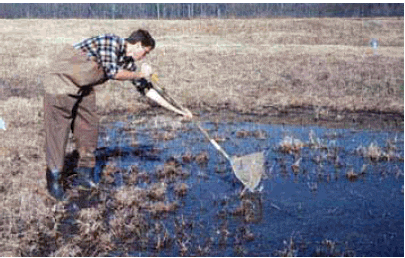
Management of a crawfish population after flood-up is complicated by the inability of producers to assess the population accurately. Because of continual recruitment and difficulties in sampling, crawfish producers have little knowledge of the density and structure of the crawfish population in their ponds. Sampling is crude and accomplished by dip net sweeps and baited traps (Figure 2). Population management entails little more than controlling timing of the flood to coincide with normal reproduction peaks, ensuring adequate water quality and food resources and adequate harvesting pressure to remove market size animals. Reducing densities to control overpopulation in ponds has shown promise in limited research but has not yet become a common practice. Supplemental stocking in underpopulated ponds within a production season sometimes occurs but may not always be feasible.
Supplemental Feeding
As described in the forage section of this manual, crawfish production in the southern United States relies almost solely on established forage crops for providing nourishment to growing crawfish. Feeding of prepared feeds is not a common practice as it is in shrimp farming or most fish farming enterprises. Rather, crawfish receive their sustenance from sources within a complex food web, similar to that which occurs in natural habitats. The natural food chain, at times, may be inadequate to sustain maximum crawfish production, especially when forages become depleted or when adequate forage crops are not established. It is also likely that, as crawfish density increases beyond some optimum density, natural food resources become depleted. Under these conditions, production of highly nutritious invertebrates, important components of the crawfish’s diet, may be lacking, resulting in poor crawfish growth or, worse, stunting at submarketable sizes.
Feeding or supplementing natural food resources has been tried by some producers to increase crawfish production. Farmers have provided hay in place of, or in addition to, growing vegetation. Hay has been added either at the beginning of the season prior to flood-up or later in the season after the depletion of standing vegetation. Large round bales or numerous smaller square bales have been placed in ponds, often marginally distributed within the ponds, with bales either left intact or broken up to some degree. Conventional thinking at the time was that hay would undergo decomposition similar to forage crops to furnish the needed “fuel” for the food chain. Positive results, in terms of more or larger crawfish harvested, were usually nondetectable and often the practice resulted in deterioration of water quality.
Lack of (or poor) results from hay supplements was due to the fact that the hay did not function as plant fragments from standing forage crops would. First, the distribution of hay, even if bales were well dispersed in the pond, usually only covered a small fraction of the entire surface area of the pond. This restriction was not conducive to maximum benefit because crawfish, and their prey, are well scattered throughout the pond and commonly do not congregate to feed. Second, decomposing plant material is most nutritious for a relatively short period (days to weeks, depending on water temperature), so anything less than regular offerings of fresh hay, well-dispersed over the entire pond area, does not meet the nutritional needs of the organisms in a pond over the course of a season. Furthermore, large amounts of decomposing hay are wasted because it cannot be fully utilized by the target organisms and can lead to oxygen depletion, either locally surrounding the bale or over the entire pond.
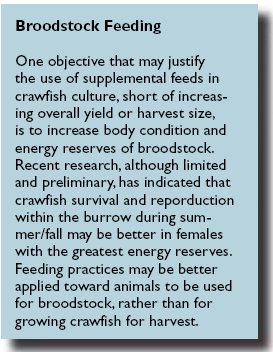
Various agricultural byproducts, such as manures, sweet potato and sugarcane products have been evaluated as supplemental feeds for crawfish production, but most have provided no noticeable or only marginal results and are considered nonpractical. The problems arise more from practical aspects of handling, frequency requirements of feeding and distribution over the pond, rather than strictly nutritional limitations. Feeding of formulated, pelleted feeds, much like those used in catfish culture, have been tried in a number of commercial and experimental crawfish ponds over the years. Positive results were inconsistent and difficult to measure, and feeding practices frequently proved uneconomical even when a positive biological response was observed. Although some carefully controlled studies showed a positive response of crawfish to supplemental feed additions, results were variable and unpredictable. Some studies reported no increase in average yield or harvest size after feeding. Others reported significant increases in yield; however, yield increases were mostly from an increase in the harvests of smaller, low-valued crawfish.
Supplemental feeding studies under simulated pond conditions in outdoor tanks or in a laboratory setting with high densities of crawfish consistently demonstrated the limitations of forage-based culture systems and usually yielded more, or larger, crawfish. Yet, repeatedly, responses from supplemental feeding in ponds were marginal and unpredictable at best and proved disadvantageous at times. It was found that feeding while harvesting could actually result in lower yields – possibly because of satiation of crawfish appetites or interference with the attractant from the bait in traps, resulting in lower catches. Feeding immediately after the last day of harvest each week, when using an intermittent harvesting schedule of three to four consecutive days per week followed by a three- or four-day reprieve from harvesting lessened the chance of reduced yields when feeding but did not always eliminate it. (Also see Managing Harvest below).
In short, there are probably times when the food chain associated with a forage crop is limited and nutritional supplementation may be needed to sustain maximum production. Aside from concerns with feeding and harvesting, however, other constraints that currently limit the economic use of supplemental feeds include knowing when feed is needed, how much to feed, how often to feed, specifically what nutrients are limited and when feeding will predictably produce positive results. If most of the crawfish population has reached or is nearing sexual maturity (even at a small size), further growth is limited, even with ample food. Therefore, much of the benefits of supplemental feeding will not be realized. Furthermore, it is difficult to obtain an accurate assessment of crawfish populations, and, based on research, it has been determined that supplemental feeds offered to highly overcrowded crawfish populations may be only marginally effective at increasing average size or yield. Therefore, without the ability to accurately assess situations in a pond and counter with cost-effective feeding practices that will yield positive results on a consistent and predictable basis, no dependable recommendations exist for use of supplemental feeds in forage-based crawfish ponds.
Feeding expensive feeds, formulated to meet all the nutritional requirements of the cultured animal (as in catfish production), may not be the most cost-effective means of supplementing the nutritional needs of crawfish. Since foragebased systems inherently furnish much of the required nutrition for growing crawfish, low-cost, incomplete feeds used as true supplements to the natural food web may provide the most cost-effective alternative. Because of the intermittent feeding nature of crawfish and the presence of other invertebrates, much of the dispensed feed will cycle through the food web to be utilized indirectly by crawfish. Therefore, supplemental feeding must be viewed as “feeding the total system” and not just the crawfish. Based on what is known about crawfish ponds, it is likely that protein and/or energy are the primary limiting factors when natural foods become scarce. Therefore, single feedstuffs high in energy or protein may provide adequate nutritional supplementation at a fraction of the cost of expensive, formulated “complete” feeds containing vitamins, minerals and other expensive nutrients.
Certain agricultural grains and seeds may be appropriate supplemental feeds for crawfish raised in ponds containing some natural foods. Agricultural seed crops are usually high in protein and/or energy, are routinely available in crawfish farming regions, are easy to apply and are usually a fraction of the cost of high protein formulated feeds. Damaged (broken) or low-grade products are often available at reduced prices. Rice grains and whole soybeans, among other grains, have been investigated as supplements to crawfish with encouraging results in highly controlled conditions. When repeatedly evaluated under realistic field conditions, however, similar problems existed with harvesting, timing, assessments and predictability, as with the use of pelleted feeds. Nonetheless, research is continuing to investigate strategies whereby supplemental feeds might be used to effectively augment the forage-based system and increase economic returns in a more reliable manner. As of yet, no feeding recommendation is available for increasing production or average harvest size in forage-based systems on a predictable and feasible basis.
Some research has been directed at the use of feeds in “off-season” or “year-round” nonforage-based crawfish ponds. Under that scenario, feeds are intended to furnish nearly all of the nutritional needs of growing crawfish – much like intensified catfish operations. Although experimental results were encouraging, no large commercial operation has yet employed this type of production system. Moreover, because of the increased cost of producing crawfish in such a system, the breakeven price is increased dramatically, making it more suitable for crawfish culture outside of Louisiana near prime out-of-state markets.
Although in high-density permanent monocropping ponds low reproduction efficiency may be offset by large numbers of crawfish, this balance is usually not the case in new or rotational ponds requiring stocking. Since a limited number of brood crawfish are initially stocked in first year ponds, reproductive condition is important. Crawfish broodstock are often obtained from densely populated ponds and at a time when food availability is at its lowest, so improvement in reproductive condition through short-term feeding prior to capture of broodstock may improve survival and reproductive success after stocking, especially if new ponds will be drained soon after crawfish are stocked. Little research has been completed with regard to this objective for feeding, but an active research program is underway to determine the merits of such short-term feeding practices and to establish some possible guidelines.
Managing for Larger Crawfish
Factors affecting crawfish size
Developments in the Louisiana crawfish industry and its major market outlets over the last 15 years have led to an increased interest and economic incentive for production of larger crawfish. Until about the late 1980s farm-gate pricing was influenced largely by supply and demand with little regard to crawfish size as long as it was above the minimum acceptable size of about 30-count crawfish to the pound. Therefore, the principal emphasis of management for crawfish producers was to maximize total production of harvestable crawfish. A number of factors, however, combined to result in the development of price differentials according to crawfish size. These included a small, short-lived export market (demanding only the largest crawfish), development of mechanical grading practices and an increased reliance on live markets as Louisiana’s processing industry was undercut by cheap imports of crawfish meat from the People’s Republic of China during the 1990s.
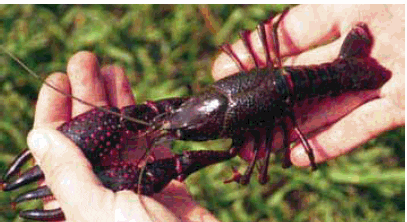
Price differentials favor the larger crawfish (Figure 3); however, there are currently no industry standards as with the shrimp industry and many other seafoods. The number of grades and grade category classifications vary depending on geographic region and time of the year, as well as among individual wholesalers and distributors. Aside from price differentials, producers of small crawfish are further constrained because of the lack of opportunity for selling smaller crawfish at certain times of the year at any reasonable price. With the loss of much of Louisiana’s processing industry during the 1990s, opportunities for salvaging the catch of smaller crawfish at those times when consumer demand is only for the largest animals have been greatly reduced.
Small crawfish are often associated with higher overall yield potential. If the percentage of small crawfish in the catch becomes great enough, however, buyers will often refuse delivery, leaving producers with few viable options. Also, in times of oversupply, those producers with the largest crawfish are most able to sell their product. Currently, excess production of small, low-value crawfish is a major industry problem and can be economically devastating to individual producers. Therefore, the principal focus of managers is now on maximizing yields of larger crawfish and/or on increased production within the early season when demand exceeds supply.
Although not thoroughly characterized, some of the factors influencing crawfish growth or size-at-harvest are thought to include harvesting strategy, certain water conditions, food quality and quantity, population density, genetic influences or combinations of these factors. Little information exists of direct genetic influences on crawfish growth or size-at-maturity, and most data indicate that environmental factors are far more important than genetic effects.
The first form of grading, or size selection for harvested crawfish, is the wire-mesh trap. As indicated in Chapter 8, the industry has largely moved to the 3/4-inch square mesh trap, which retains smaller crawfish. Harvest intensity also can affect the size of crawfish in the catch. Intense trapping efforts (with high trap density and/or frequent harvests) usually increase overall yields, but can decrease the average size by temporarily decreasing the density of larger crawfish and removing some crawfish before they have sufficient time to grow to larger sizes. Insufficient harvesting can foster overpopulation, which in turn hastens forage depletion and contributes to the stunting of crawfish at sub-desirable sizes. Trap-soak (set) time also can affect the size of crawfish in the catch, because small crawfish are more effective at exiting the trap. Longer trap soak times generally yield larger crawfish.
The most obvious effect on crawfish harvest size relating to water conditions is water temperature. At temperatures below about 60 F, growth slows considerably and, while trap catch efficiency is also reduced, smaller crawfish size is usually the result of concerted harvesting efforts at the lower temperatures. Chronic low oxygen concentrations also can suppress crawfish growth, and rising water temperatures and highly fluctuating water levels are thought to encourage growth to slow or stop in conjunction with maturation, even at smaller sizes.
It was once thought that the overwhelming factor causing the excessive production of small or stunted crawfish in production ponds was food deficiency. Harvests of stunted populations are nearly always associated with premature depletion of the forage resource. It is likely that as crawfish density increases beyond some optimum level, food resources are depleted and nutritional shortages limit growth. Research has shown, however, that crawfish grown at more than about 15 per square yard will have a slow growth rate and small size at maturity even with supplemental feeding of high-quality feeds. It has been clearly demonstrated that crawfish exhibit density-dependent growth. Final size appears to be inversely related to density, and high feeding rates with high quality diets are unable to counteract the effects of density on crawfish growth. Research suggests that the overwhelming factor affecting size-at-harvest in commercial crawfish ponds is not simply food shortages, as was once thought, but principally overcrowding.
Managing density
Few sound management strategies exist for the predictable production of large crawfish in commercial ponds, mainly because stock replenishment depends on natural recruitment, which is affected by many variables outside of the control of pond managers. High population density has been identified as the single most limiting factor affecting crawfish growth and harvest size, yet control of crawfish numbers is possibly one of the most elusive aspects of crawfish pond management. The density of young-of-the-year crawfish in ponds is influenced by many factors but is basically a function of the number and size of successfully spawning broodstock and the survival of their young. Overpopulation is most likely to occur in permanent monocropping ponds after several annual production cycles and is least likely in newly established ponds or in ponds previously out of production for some time. Therefore, rotating production into different fields, as is commonly used in some rice/crawfish rotational practices, or allowing a permanent pond to remain drained for one or more complete cycles can be a management technique for preventing overpopulation when production resumes. For producers with limited land, however, suspension of production in ponds for an entire season could lead to loss of revenue that might outweigh the benefits of population control.
If overcrowding is expected, delaying the permanent flood to December or later, well after the peak spawning period, might be a suitable method of preventing stunting in ponds because delaying would likely reduce the number of recruitment classes, although this method has not been well documented. It also could delay the bulk of crawfish production, which is usually accompanied with lower prices. Caution must be emphasized with this approach because if cool weather prevails late into spring and/or ponds become deficient of food resources, many late recruits may not have time to attain large harvest size before ponds are drained in summer.
When permanent monocropping ponds are overcrowded, another possible technique to reduce recruitment the following season is to drain the ponds earlier than normal, before too many crawfish become sexually mature and begin mating, and to drain them rapidly, thereby stranding many crawfish before they have sufficient opportunity to burrow (Figure 4). This method may not always be effective, particularly in older ponds where established burrows are plentiful and mature broodstock are available at all times. If sufficient broodstock mature and burrow before the drain and reproductive success is high, this technique will fail to achieve the desired result. Early drains also can cause a significant loss of income since harvesting ceases prematurely.
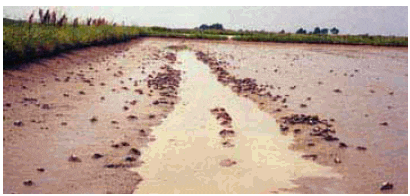
Since most mature broodstock establish burrows in exposed surfaces of the pond, namely the levees, farmers have an additional opportunity to reduce population density for the subsequent season. After the ponds are drained for the summer, they could conduct maintenance or renovation on a substantial portion of the levees. Such activities can significantly reduce crawfish reproduction and/or recruitment. Although not a very precise method, major disturbance of burrow entrances can reduce the survival, reproduction or emergence of the occupants.
If the right proportion of linear levee, especially the interior area of the levee, is reworked with heavy equipment between seasons, overpopulation may be corrected or reduced from one season to the next. If too many burrows are compromised in this manner, however, overcorrection is possible and yields and profits suffer. Because of the many variables associated with reproduction and recruitment success, and the typical nonuniform burrow patterns in the levees, general management recommendations cannot be provided for this imprecise method of population control. It is recommended however, that at least some percentage of the levee area remain undisturbed during the critical burrowing period to provide an opportunity for some reproduction and recruitment to occur normally.
All of the previously mentioned methods for correcting overpopulation are based on preventative measures, taken to prevent recurrence in a subsequent season. Since the cause of overpopulation is highly variable and largely dependent on environmental factors beyond the manager’s control, preventive measures are frequently ineffective, or to the contrary, over-compensatory, and loss of production (and income) is a possibility. Practices required to readily identify overcrowding and corrective actions that yield predictable results within a production season are lacking. Some research, however, has been focused on this approach with mixed results.
Pond sampling, beginning six to eight weeks after floodup, is important in determining population density and potential for overcrowding. Although accurate sampling protocols are lacking for crawfish aquaculture, an experienced manager should be able to ascertain relative density estimates with a combination of sampling gear such as dip nets and baited traps (both small and large mesh traps) and visiting the pond at night with a light around the edges. If overcrowding is anticipated, actions taken to reduce crawfish densities within a current production season should probably occur after peak recruitment, which occurs from October to December, but before ponds warm in the spring. Density reductions before peak recruitment occurs may not be adequate if large numbers of subsequent recruits appear. Reductions too late in the spring may accompany food shortages and reduced opportunity for maximum growth.
Research and anecdotal evidence has indicated that when overcrowding was determined, temporary and partial pond draining in February or early March in South Louisiana was sometimes sufficiently effective in reducing crawfish density to result in larger crawfish after refilling. Ponds were drained, except for puddles and ditches amounting to about 10 percent to 30 percent of pond bottom areas, for two to seven days and then refilled. Density reduction occurred as a result of concentrating the crawfish in a limited area where they were more exposed to the hazards of predation and cannibalism.
In theory, although not verified, more deaths should occur in the younger age classes with this method – and this would be the preferred outcome. It should be clearly noted, however, that mixed results have been obtained with this risky approach. In some cases, crawfish reductions were insufficient to affect a positive response after refilling, and in other cases over-reductions occurred, resulting in larger crawfish but also in a substantial reduction in yield. Because of the unpredictability of this method and various circumstances that could affect outcomes, no management recommendations have yet been devised. The success of midseason draining to reduce overcrowding and produce subsequent harvests of larger crawfish depends first on accurate assessment of population density and then appropriate density reduction at the appropriate time – a difficult task with any measure of predictability.
Other possible means of reducing density within a season, including intensive harvesting with both small-mesh and commercial traps, have been investigated without success. Because of the inefficiency of current harvest methods, it is unlikely that sufficient reduction in density can occur using only baited traps.
Managing food resources
Although population density appears to be the single most important factor determining crawfish growth and size-at-harvest in typical production ponds, limited food resources also can be a significant contributing factor. Moreover, high crawfish density can significantly increase the rate of depletion of the forage in ponds, creating food shortages that act to exacerbate density’s effect on harvest size. To date, supplemental feeding has had little impact on increasing size-at-harvest in ponds; however, its use at various densities and under varied conditions has not been thoroughly investigated. A well-managed forage-based system seems to be an appropriate feed delivery strategy and remains the best way to ensure the most cost-effective transfer of nutrients to growing crawfish when population density is within the optimum range.
Certain management considerations are necessary to ensure maximum use of food resources from forage-based production. Probably the single most desirable aspect in any vegetated system is the ability of the forage to continually and consistently furnish adequate amounts of material to the food chain for the duration of the production season. As detailed in Chapter 5, research has shown that plant type (and variety) and plant maturity status have major effects on persistence and re-growth potential. The ability to achieve adequate re-growth, as a function of variety selection, planting date, standing density of crawfish and, if necessary, water management have been directly linked with increased production of larger crawfish late in the harvest season – where it is often the most beneficial. Mixtures of plant types that bring complimentary benefits in terms of food value and vertical structure, especially late in the season, also may yield positive results related to increasing average crawfish size at harvest.
Research is continuing to investigate management approaches to improve forage-based systems and their application in crawfish production. Also, with a better understanding of crawfish population dynamics, feeding habits and nutritional needs, a cost-effective supplemental feeding program eventually may be devised to aid producers in achieving larger crawfish.
Managing harvest
Modification of the typical harvesting routine also has shown some potential to increase crawfish size-at-harvest. Intense trapping five to six days per week can reduce harvest size by removing some animals from the population before they could otherwise grow to a more desirable market size. A threeor four-day per week harvest approach, as discussed in Chapter 8 usually can increase efficiency of harvest as well as overall crawfish size. Intermittent or rotational harvest schedules also have been shown to increase the proportion of large crawfish in the catch. When an entire pond or portions of a pond are harvested on an intermittent basis, crawfish have an opportunity to undergo additional molt(s), thus increasing crawfish size and value between trapping episodes. Various periods of trapping/ nontrapping, as well as use of supplemental feeds during the nontrapping period, have been investigated, although additions of pelleted feeds in a limited number of studies did little to increase yield or size-at-harvest. Generally, in controlled studies, short term (two to four weeks) intermittent trapping has increased crawfish harvest size but at the expense of total yield, probably from decreased trapping frequency – that is, fewer trap-sets per season.
The usefulness of an intermittent harvest schedule depends on many factors, such as population density and size structure, food availability, time of year, trap density and marketing conditions. It should be clearly noted, however, that under some conditions of pond culture, notably overcrowding, food shortages or when a majority of crawfish are nearing or have reached their maturity molt, harvesting reprieves are not effective at increasing crawfish size. LSU AgCenter researchers, as well as individual producers, are continuing to explore different trapping strategies and trap designs for their effectiveness with regard to producing larger crawfish.
Another option that is currently used to reduce small crawfish offered for sale is the use of “hand grading” or “in-boat graders” (see Chapter 8). Some low-volume producers may hand cull subdesirable crawfish, while many producers currently use a device that consists of parallel bars attached to an inboat sacking table. Various bar spacings are used, but the intent is for sub-desirable size crawfish to fall through a platform of parallel bars mounted in the bottom of the sacking table when crawfish are emptied onto the table from the trap. Crawfish that fall through the bars are usually funneled back into the pond, while crawfish that are retained above the bars are moved into sacks for sale.
A common misconception with this approach is that the smaller crawfish returned to the pond will be harvested later at a larger, more valuable size. Though in some cases this may be true for a small percentage of animals, many crawfish will never be recaptured because of natural or predator-related mortality and the inefficient nature of trap harvesting. In many cases, reharvested crawfish will be caught later at reduced prices. Moreover, returning crawfish to a pond that is overcrowded and/or deficient in food resources may exacerbate those problems, resulting in a reduction of average crawfish size in subsequent harvests. In many cases, it may be better, and more profitable, to sell the smaller crawfish, even at a much reduced price, than to return them to the same pond. Alternatively, submarketable crawfish may be deposited in a pond that is known not to be overcrowded, with the intentions of harvesting later, a practice known as “relaying,” although the economic advantage of this practice is not always certain and should be scrutinized carefully.
Relaying to increase crawfish size
The presence of small, stunted crawfish in the catch usually occurs near the end of the production season (late April-June in Louisiana), which normally coincides with the period of lowest prices. By that time, forage resources often have been depleted, crawfish have reached maturity and further growth is unlikely. On some occasions it has been possible to achieve further growth from severely stunted populations by transferring, or relaying, crawfish from their original surroundings in poor environments to improved environments. Although this practice has been rarely used, research has demonstrated its potential for increasing crawfish size, thus their value and marketability. Suitable conditions exist on many farms for use of this practice, not only to increase market value of crawfish but to extend the harvest season and increase net returns from already-integrated agriculture operations. Because many farmers co-culture crawfish and rice in rotational systems and because these cropping seasons overlap, it is common to have newly established rice fields at a time when crawfish stunting normally occurs in forage- depleted crawfish ponds. Overlapping seasons provides the opportunity of using the rice production acreage as a valuable resource for obtaining additional growth and increasing the market value of crawfish. Research has shown that, with careful management, acceptable rice yields can be obtained following harvest of relayed crawfish, and potential net farm income could be substantially increased by intercropping crawfish in a rice crop in this manner. It should be noted, though, that some rice yield will invariably be sacrificed because of crawfish harvesting activities, primarily through plant destruction associated with trapping lanes. Extreme caution should also be exercised regarding pesticide use in the rice crop.
This intercropping approach may be particularly suitable to rotational culture systems where crawfish culture follows the rice crop. In lieu of the normal practice of stocking broodstock, this practice calls for stocking of stunted animals at much higher densities in the young rice crop. Following several weeks of growth, most of the larger, higher-value crawfish would be reharvested prior to rice maturity, and any remaining animals would suffice as broodstock for the subsequent crawfish season. Stocking rates of up to 1,000 lb/ac have been investigated, but it should be noted that, although individual crawfish weight more than doubled, retrieval rates were lowest for the higher stocking rates, and the overall harvest recovery rate was equal to the amount of crawfish stocked.
The economical feasibility of relaying or any other management practice intended to increase the production of large crawfish in a commercial operation depends on a price structure to the producer that favors larger crawfish. The magnitude of the price differential for large crawfish will determine the economic benefit of management practices that focus on anything other than optimum yields of medium-size animals. Market demands and price differences should always be taken into account when implementing or recommending costly management practices.
Diseases
Serious disease problems associated with nonintensive crawfish culture are thought to be rare. Individual crawfish are known to be susceptible to various pathogens, such as bacteria, virus, fungi, protozoans and parasites; however, epidemic outbreaks sufficient to affect commercial production in earthen ponds have not been demonstrated. Significant disease problems are more likely to be encountered in intensive, high-density holding systems, such as purging and soft-shell production facilities. One study reported that of 15 outbreaks of bacterial septicemia (Vibrio mimicus and V. cholera) diagnosed in Louisiana crawfish, four cases were from ponds and 11 were from high-density holding systems. Diseases are most likely to occur during periods of elevated temperatures and/or periods of oxygen stress.
All North American crawfish are suspected vectors of the Aphanomyces fungi, or plaque fungus, that was notorious for eliminating many populations of native European crawfish in numerous lakes, rivers and streams. Although carriers, North American crawfish, including those cultured in the South, are not normally affected by the fungus. Procambarid crawfishes are sometimes affected by other agents that do not necessarily have an effect on production but may hinder crawfish marketability because of certain physical effects. Microsporida can infest the abdominal muscle, giving it an unattractive milky-white appearance (porcelain disease), and various ectocommensal organisms that attach to the exoskeleton can limit the acceptability of crawfish if the infestation is heavy. These conditions are not usually common and have little economic impact, although at times buyers may refuse to accept lots of crawfish with heavily soiled exoskeletons.
Because of the insignificance of known diseases in pond culture of crawfish, disease management is not deliberate. Practices that prevent food shortages, overcrowding and low oxygen (common stressors) are the extent of practices related to disease management in the crawfish industry.
Predators
Crawfish are, however, susceptible to any number of predators that thrive in and about the shallow, vegetated waters of crawfish ponds. Predaceous aquatic insects consume young, recently molted crawfish. Bullfrogs, amphiumas (a large eellike salamander) and several species of water snakes flourish in crawfish ponds and readily consume all sizes of crawfish (Figure 5). Various turtles and the occasional alligator will prey on crawfish. Small mammals, such as the Norway rat, mink, raccoon, opossum and otter are often abundant and will consume crawfish and sometimes the bait placed in crawfish traps. Raccoons and otters also will damage traps when getting to the crawfish and/or bait. Although collectively these predators can consume large quantities of crawfish, crawfish reproduction and growth rates are usually sufficient to prevent major harvest losses.
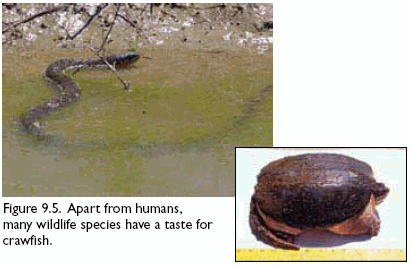

Even though predatory fish, if not controlled, can be the most significant predator encountered in crawfish ponds, avian predators, especially carnivorous wading birds, are perceived by many producers to cause the most harm. Fish are easily controlled, though often difficult to eliminate from ponds if they become established (Figure 6). Fish are controlled by thoroughly drying pond bottoms during the interval between seasons or by treating standing pools of water with a fish toxicant, followed by proper screening of incoming water. Some fish manage to enter ponds by swimming up drain structures or on the feet, feathers or fur of other animals visiting the ponds. If not controlled, fish will consume large quantities of crawfish and/or compete with crawfish for the natural food items that crawfish rely on.
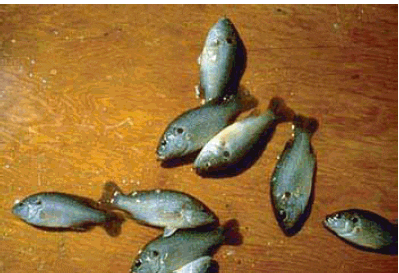
Avian predators are not as easy to control as fish. Many bird species consume crawfish, and, except for allowable hunting seasons for certain waterfowl, nearly all piscivorous (fisheating) birds are federally protected. Although the actual impact on operational costs and production is not known, many producers perceive bird depredation as a significant and growing problem. Carnivorous waterbirds find crawfish ponds to be food-rich havens, and these ponds often offer water and food resources when they are in short supply in natural habitats. Some researchers have provided convincing evidence of a direct relationship between the increase in colonial wading bird numbers from the 1960s to 1980s and the increase in crawfish pond acreage in Louisiana during that period. Anecdotal evidence also suggests that some noncrawfish-eating species have recently adapted their feeding habits to take advantage of the plentiful supply of crawfish from aquaculture ponds. Effective control measures are lacking, and the size and shape of most commercial crawfish ponds prevent the economical use of netting or other exclosures.
March 2010
